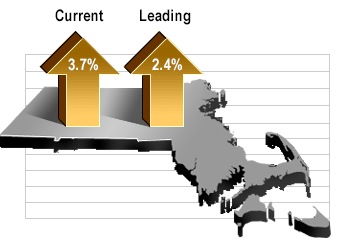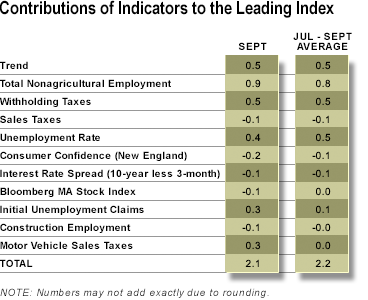State economy continues to outpace the U.S. in 3rd quarter
Weak global economy and tightening labor markets weigh heavily on economic outlook.
September 2016
 Massachusetts real gross domestic product grew at an annual rate of 3.7 percent in the third quarter of 2016 according to the MassBenchmarks Current Economic Index. Nationally, real gross domestic product grew at a more modest annual rate of 2.9 percent during the same period. MassBenchmarks, the journal of the Massachusetts economy, is published by the UMass Donahue Institute in collaboration with the Federal Reserve Bank of Boston. Based on the latest available data, MassBenchmarks now estimates that the state's economy expanded at a 3.6 percent rate in the second quarter and 2.0 percent in the first quarter of this year, as compared to U.S. growth of 1.4 percent in the second quarter and 0.8 percent in the first quarter, as estimated by the U.S. Bureau of Economic Analysis.
Massachusetts real gross domestic product grew at an annual rate of 3.7 percent in the third quarter of 2016 according to the MassBenchmarks Current Economic Index. Nationally, real gross domestic product grew at a more modest annual rate of 2.9 percent during the same period. MassBenchmarks, the journal of the Massachusetts economy, is published by the UMass Donahue Institute in collaboration with the Federal Reserve Bank of Boston. Based on the latest available data, MassBenchmarks now estimates that the state's economy expanded at a 3.6 percent rate in the second quarter and 2.0 percent in the first quarter of this year, as compared to U.S. growth of 1.4 percent in the second quarter and 0.8 percent in the first quarter, as estimated by the U.S. Bureau of Economic Analysis.
State economic growth continued at a strong pace in the third quarter. Although the underlying indicators were mixed, Massachusetts employment and earnings expanded strongly and the state's unemployment rate plummeted during this period. Payroll employment grew at a 2.3 percent annualized rate in the third quarter, following an exceptionally strong 3.1 percent rate of growth of in the second quarter. Employment levels in the third quarter were 2.0 percent higher than in the third quarter of 2015. Wage and salary income, as estimated from state withholding tax revenue, expanded at an 11.4 percent rate in the third quarter, after growing at a 13.7 percent rate in the second quarter. Year over year, wage and salary income was 6.5 percent higher than in the third quarter of 2015.
U.S. jobs and earnings growth, though solid, was slower than that experienced in Massachusetts. In the third quarter, U.S. payroll employment grew at a 1.7 percent annualized rate, following growth at a 1.3 percent rate in the second quarter. Year over year, U.S. employment was 1.7 percent higher than in the third quarter of 2015. MassBenchmarks estimates that U.S. wages and salaries expanded at a 4.8 percent rate in the third quarter (the official U.S. personal income data will be released on October 31), after growing at a 4.7 percent rate in the second quarter.
The state's headline unemployment rate—the U-3 measure—stood at 3.6 percent in September, down from 4.2 percent in June, and from 4.8 percent in September of 2015. The U.S. unemployment rate in September was 5.0 percent, barely changed from June (4.9 percent), and September of 2015 (5.1 percent). The Massachusetts unemployment rate is now a full percentage point below its pre-recession low (4.6 percent) and at the lowest level in over 15 years.
The rising tide in the state's labor market is increasingly lifting more boats as can be seen in the decline in the broader U-6 measure of unemployment, which includes those who are working part-time but want full-time work, as well as those who are marginally attached to the labor force. The Massachusetts U-6 rate in September was 8.2 percent, down from 8.4 percent in June and 9.7 percent in September of 2015. This is lowest it has been since the onset of the Great Recession (March 2008). The pre-recession low was reached in September 2007 when the U-6 rate stood at 7.1 percent.
Consumer and business spending on items subject to the state regular sales tax declined slightly, shrinking at a 0.6 percent annualized rate in the third quarter after growing at a 5.5 percent rate in the second. Over the past year (Q3 2015 to Q3 2016), this measure of spending grew 1.4 percent. The recent slowdown in taxable spending given the strength of the labor market and earnings is puzzling analysts, even leading the Baker administration to lower tax revenue expectations for the current fiscal year (which ends in June 2017). It may reflect in part a return to normal spending on automobiles after last year's record pace, a reaction to weak and uncertain stock markets earlier in the year, an acceleration in the shift towards on-line spending—most of which escapes the regular sales tax, or weaker spending by businesses, who pay sales taxes on most purchases of supplies and equipment.
"It is unlikely that the pace of employment and earnings growth in Massachusetts can continue at the current pace given weak global economic performance and demographic constraints on labor force growth," noted Alan Clayton-Matthews, MassBenchmarks Senior Contributing Editor and Associate Professor of Economics and Public Policy at Northeastern University, who compiles and analyzes the Current and Leading Indexes. The MassBenchmarks Leading Index predicts that the state economy will grow at a more moderate pace over the next six months, at a 2.4 percent annualized rate in the fourth quarter, and at a 2.1 percent pace in the first quarter of 2017.
 "The headwinds holding back state growth have not changed in recent months. A major headwind is the tightening labor market. With fewer unemployed workers and with more baby boomers retiring, it is becoming more difficult for employers to find the workers they need. This is reflected in the historically low levels of initial unemployment claims, a signal that employers are reacting to the tightening labor market by holding on to the workers they have. Tight labor markets may become a constraint on the Commonwealth's capacity to grow," Clayton-Matthews added.
"The headwinds holding back state growth have not changed in recent months. A major headwind is the tightening labor market. With fewer unemployed workers and with more baby boomers retiring, it is becoming more difficult for employers to find the workers they need. This is reflected in the historically low levels of initial unemployment claims, a signal that employers are reacting to the tightening labor market by holding on to the workers they have. Tight labor markets may become a constraint on the Commonwealth's capacity to grow," Clayton-Matthews added.
The 10 indicators that comprise the leading index usually do not all move in tandem. Typically, some may indicate an expectation of faster than average growth, while at the same time others may indicate an expectation of slower than average growth. The following table accounts for the contributions of each towards faster or slower growth than the recent underlying trend of 0.5 percent. The index value is their sum.
In September, five indicators contributed to a forecast of above-trend growth: total nonagricultural employment, withholding taxes, the unemployment rate, initial unemployment claims, and motor vehicle sales taxes. Five indicators contributed to below-trend growth: sales taxes, consumer confidence, the interest rate spread between 10 year and 3 month U.S. Treasury securities, the Bloomberg stock index for Massachusetts, and construction employment.
 In the three-month period July through September, four indicators contributed to a forecast of above-trend growth: total nonagricultural employment, withholding taxes, the unemployment rate, and initial unemployment claims. Three indicators contributed to average-trend growth: the Bloomberg stock index for Massachusetts, construction employment, and motor vehicle sales taxes. Three indicators contributed to below-trend growth: sales taxes, consumer confidence, and the interest rate spread between 10 year and 3 month U.S. Treasury securities.
In the three-month period July through September, four indicators contributed to a forecast of above-trend growth: total nonagricultural employment, withholding taxes, the unemployment rate, and initial unemployment claims. Three indicators contributed to average-trend growth: the Bloomberg stock index for Massachusetts, construction employment, and motor vehicle sales taxes. Three indicators contributed to below-trend growth: sales taxes, consumer confidence, and the interest rate spread between 10 year and 3 month U.S. Treasury securities.
The current and historical quarterly estimates for state domestic product growth include adjustments for changes in productivity growth. These adjustments are estimates of the quarterly deviations from the 1978-2015 trend in the growth of the ratio of output to employment. In the third quarter of 2016 these adjustments subtracted 1.3 percentage points from growth. In the second quarter of 2016, these adjustments subtracted 2.3 percentage points from growth. In the first quarter, these adjustments subtracted 3.5 percentage points from growth. For the forecast of state domestic product growth in the fourth quarter of this year and the first quarter of next year, productivity growth is assumed to return to the average of the last five years.
Several recent months of the indices are revised each release. These revisions are a result of the statistical method used to create the index, as well as revisions in the underlying indicators.
--------
All of the indicators except interest rates refer to Massachusetts. The current index is composed of four indicators: nonagricultural employment, withholding taxes, sales taxes, and the unemployment rate. The leading index includes these four current indicators plus the other six (leading) indicators in the contributions table. All of the indicators are as of September, except for interest rates and the Bloomberg stock index for Massachusetts, which are through October 21. The MassInsight Consumer Confidence Index is released every third month. Intervening months are interpolated, and changes in the Conference Board's Consumer Confidence Index for the U.S. are used to extrapolate to the current month of the index, as needed. Series measured in current dollars or values, i.e., withholding taxes, sales taxes, the Bloomberg stock index, and motor vehicle sales taxes, are deflated by the U.S. consumer price index for all urban consumers, excluding food and energy.
For a description of the methodology used to construct these indices, see: Alan Clayton-Matthews and James H. Stock, "An application of the Stock/Watson index methodology to the Massachusetts economy," Journal of Economic and Social Measurement, vol. 25 (1998/1999), pp. 183-233.
Dr. Alan Clayton-Matthews
MassBenchmarks
Northeastern University, School of Public Policy and Urban Affairs
October 28, 2016

